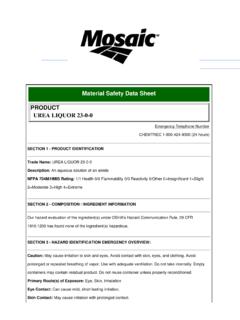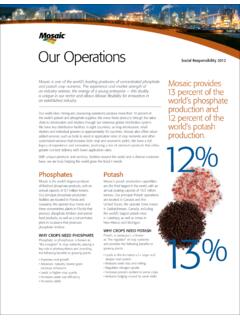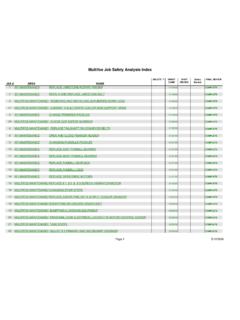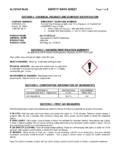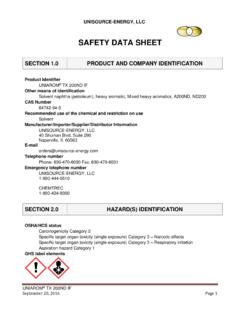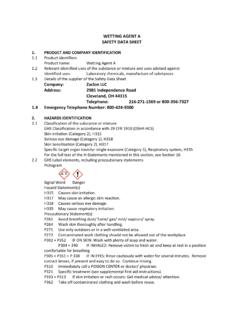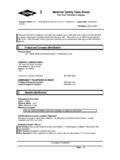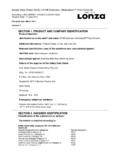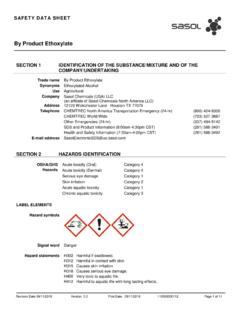Transcription of SAFETY DATA SHEET SECTION 1 PRODUCT AND …
1 Status: Revised Page 1 of 7 Issue Date: 06/01/2015 SECTION (s) Revised: 15, 16 SDS #: MOS 100011 Revision Date: 12/31/2018 SAFETY data SHEET SECTION 1 PRODUCT AND company IDENTIFICATION Trade Name: DAP - Diammonium Phosphate Chemical Name: Dibasic Ammonium Phosphate CAS Number: 7783-28-0 Chemical Family: Ammonium Pho sphates Inorganic Salt Synonyms: Ammonium Phosphate Dibasic Secondary Ammonium Phosphate Diammonium Hydrogen Phosphate Fertilizer Grade Ammonium Phosphate DAP 18 - 46 - 0 Primary Use: Crop nutrient company Information: THE MOSAIC company 3033 Campus Drive Plymouth, MN 55441 800-918-8270 or 763-577-2700 8 AM to 5 PM Central Time US Emergency Telephone: EMERGENCY OVERVIEW 24 Hour Emergency Telephone Number: For Chemical Emergencies: Spill, Leak, Fire or Accident Call CHEMTREC North America: (800) 424-9300 (reference CCN201871) Others: (703) 527-3887 (collect) SECTION 2 HAZARD IDENTIFICATION GHS Classification: Acute Toxicity Oral Category 5 Skin Irritant Category 2 Eye Irritant Category 2B STOT SE Category 3 Hazard Statement H303 Hazard Statement H315 Hazard Statement H320 Hazard Statement H335 Signal Word: WARNING Hazard Statement(s) H303: May be harmful if swallowed H315: Causes skin irritation H320: Causes eye irritation H335: May cause respiratory irritation Label Elements: Prevention: P264: Wash hands thoroughly after handling.
2 P280: Wear protective gloves P261: Avoid breathing dust P271: Use only outdoors or in a well-ventilated area. Response: P302+ P352 IF ON SKIN: Wash with plenty of water. P321 Specific Treatment, see supplemental first aid information. P332+ P313 If skin irritation occurs: Get medical advice/attention. P362+ P364 Take off contaminated clothing and wash it before reused. P305+P351+ P338 IF IN EYES: Rinse cautiously with water for several minutes. Remove contact lenses, if present and easy to do. Continue rinsing. P337+ P313 If eye irritation persists: Get medical advice/attention. Status: Revised Page 2 of 7 Issue Date: 06/01/2015 SECTION (s) Revised: 15, 16 SDS #: MOS 100011 Revision Date: 12/31/2018 P304+ P340 IF INHALED: Remove person to fresh air and keep comfortable for breathing. P312 Call a POISON CENTER. Storage: Not applicable Not applicable Disposal: P501 Disposal of content/containers to be in accordance with local/regional/national regulations.
3 SECTION 3 COMPOSITION INFORMATION ON INGREDIENTS Formula: (NH4)2 HPO4 Composition: Dibasic Ammonium Phosphate Ammonium Sulfate CAS 7783-28-0 CAS 7783-20-2 70-90% Acute Toxicity Oral Category 5 Skin Irritant Category 2 Eye Irritant Category 2B STOT SE 3 (Lungs, Inhalation) SECTION 4 FIRST AID MEASURES First Aid Procedures: Eyes: Move victim away from exposure and into fresh air. Flush eyes with plenty of clean water for at least 15 minutes. If symptoms persist, seek medical attention. Skin: Wash contaminated area thoroughly with mild soap and water. If chemical or solution soaks through clothing, remove clothing and wash contaminated skin. If irritation develops and persists after washing, seek medical attention. Inhaled: If respiratory symptoms develop, move victim away from source of exposure and into fresh air. If symptoms persist, seek medical attention. Ingestion: If large amounts are swallowed, seek emergency medical attention.
4 If possible, do not leave victim unattended and observe closely for adequacy of breathing. Note to Physician: If person has been exposed to concentrated decomposition products, treat symptomatically and watch for delayed symptoms of pulmonary edema. SECTION 5 FIRE FIGHTING MEASURES Extinguishing Media: Use extinguishing agent suitable for type of surrounding fire. Avoid excessive water to minimize runoff. Prevent firefighter water from entering the environment. Small fires: Water spray, foam, dry chemical or CO2 Large fires: Water spray, fog or foam Protection of Firefighters: Positive pressure, self-contained breathing apparatus is required for all firefighting activities involving hazardous materials. SECTION 6 ACCIDENTAL RELEASE MEASURES Response Techniques: Stay upwind and away from spill (dust hazard). Wear appropriate protective equipment, including respiratory protection, as conditions warrant (see SECTION 8). Prevent spilled material from entering sewers, storm drains, other unauthorized treatment drainage systems, and natural waterways.
5 Notify appropriate federal, state, and local agencies as may be required (see SECTION 15). Minimize dust generation. Sweep up and package appropriately for disposal. Status: Revised Page 3 of 7 Issue Date: 06/01/2015 SECTION (s) Revised: 15, 16 SDS #: MOS 100011 Revision Date: 12/31/2018 SECTION 7 HANDLING AND STORAGE Handling: The use of appropriate respiratory protection is advised when concentrations exceed any established exposure limits (see SECTION 8). Avoid contact with eyes, skin, and clothing. Wash thoroughly after handling. Wash contaminated clothing or shoes. Use good personal hygiene practices. Storage: Use and store this material in dry, well-ventilated areas. Store only in approved containers. Keep container(s) tightly closed. Keep away from any incompatible material (see SECTION 10). Protect container(s) against physical damage. Material may absorb moisture from the air. SECTION 8 EXPOSURE CONTROLS / PERSONAL PROTECTION Engineering Controls: Use process enclosure, general dilution ventilation or local exhaust systems where necessary to maintain airborne dust concentration below the OSHA standards or in accordance with applicable regulations.
6 Personal Protective Equipment (PPE): Eye/Face: Approved eye protection to safeguard against potential eye contact, irritation, or injury is recommended. Skin: The use of cloth or leather work gloves is advised to prevent skin contact, possible irritation and absorption. Respiratory: A NIOSH approved air purifying respirator with a type 95 (R or P) particulate filter may be used under conditions where airborne concentrations are expected to exceed exposure limits. Protection provided by air purifying respirators is limited (see manufacturer's respirator selection guide). Use a positive pressure air supplied respirator if there is potential for uncontrolled release, exposure levels are not known or any other circumstances where air purifying respirators may not provide adequate protection. A respiratory protection program that meets OSHA's 29 CFR and ANSI requirements must be followed if workplace conditions warrant a respirator.
7 Other: A source of clean water should be available in the work area for flushing eyes and skin. General Hygiene Considerations: Wash thoroughly after handling Use adequate ventilation Exposure Guidelines: OSHA Permissible Exposure Limits (PEL): Particulates Not Otherwise Regulated: 5 mg/m3 TWA (respirable); 15 mg/m3 TWA (total) Ammonia: 50 ppm (35 mg/m3) TWA ACGIH Threshold Limit Value (TLV): Particulates Not Otherwise Specified: 3 mg/m3 TWA (respirable); 10 mg/m3 TWA (inhalable) Ammonia: 25 ppm (18 mg/m3) TWA; 35 ppm (27 mg/m3) STEL Status: Revised Page 4 of 7 Issue Date: 06/01/2015 SECTION (s) Revised: 15, 16 SDS #: MOS 100011 Revision Date: 12/31/2018 SECTION 9 PHYSICAL AND CHEMICAL PROPERTIES Note: Unless otherwise stated, values in this SECTION are determined at 20 C (68 F) and 760 mm Hg (1 atm). Appearance: Gray, tan, brown or black granules Vapor Pressure (mm Hg): Not applicable Odor: Slight ammonia odor Vapor Density (air=1): Not applicable Odor Threshold: No data available Specific Gravity or Relative Density: Not applicable Physical state: Solid Bulk Density: Loose 56 - 61 lbs/ft3 (895 - 960 kg/m3) pH: in a 1% solution Solubility in Water: 80% - 95% Melting Point/ Freezing Point: Not applicable Partition coefficient: No data available Boiling Point: Not applicable Auto-Ignition Temperature: Not applicable Flash Point: Not applicable Decomposition Temperature: 310 F (155 C) Evaporation Rate: No data available Viscosity: No data available Flammability: Not applicable Volatility: Not applicable Upper/lower Flammability or explosive limits Not applicable SECTION 10 STABILITY AND REACTIVITY Chemical Stability: Stable under normal conditions of storage and handling.
8 Decomposes at 310 F (155 C). Conditions to Avoid: Extreme temperatures Incompatible Materials: Avoid contact with alkaline materials Hazardous Decomposition Products: If heated to the point of decomposition, oxides of phosphorus, oxides of nitrogen and ammonia (NH3) may be released. Corrosiveness: May be corrosive to iron and mild steels, aluminum, zinc and copper Hazardous Polymerization: Will not occur SECTION 11 TOXICOLOGICAL INFORMATION Substance: Diammonium Phosphate Acute Oral Toxicity: LD50 (rat, oral) > 2000 mg/kg Acute Inhalation Toxicity: No data available Acute Dermal Toxicity: LD50 (rat, dermal) > 5000 mg/kg Mutagenesis: No data available Target Organ STOT SE Cat 3; may cause respiratory irritation. Developmental Toxicity: No data available Carcinogenicity The ingredients of this PRODUCT are not classified as carcinogenic by NTP (National Toxicology Program), IARC, or OSHA Status: Revised Page 5 of 7 Issue Date: 06/01/2015 SECTION (s) Revised: 15, 16 SDS #: MOS 100011 Revision Date: 12/31/2018 SECTION 12 ECOLOGICAL INFORMATION Ecotoxicology: May release ammonium ions that are toxic to fish.
9 Un-ionized ammonia concentrations above mg/l are considered toxic in fresh water. May release phosphates which will result in algae growth, increased turbidity, and depleted oxygen. At extremely high concentrations, this may be hazardous to fish or other marine organisms. Release to watercourses may cause effects downstream. Fish 96 hour LC50, OECD Guidelines 203 (rainbow trout): >86mg/L. SECTION 13 DISPOSAL CONSIDERATIONS Recover or recycle if possible. Properly characterize all waste materials. Consult federal, state/provincial and local regulations regarding the proper disposal of this material. Prevent material from entering sewers, storm drains, other unauthorized treatment drainage systems, and natural waterways. SECTION 14 TRANSPORT INFO Regulatory Status: Not regulated Identification Number: HTS Hazard Class: Not applicable Proper Shipping Name Not applicable Packing Group Not applicable DOT Emergency Response Guide Number: Not applicable Transport in bulk according to Annex II of MARPOL 73/78 and the IBC Code: Not applicable MARPOL Annex V: Non-HME IMO/IMDG: Not applicable SECTION 15 REGULATORY INFORMATION CERCLA: Not listed RCRA : Not listed SARA TITLE III: (E xemptions at 40 CFR, Part 370 may apply for agricultural use, or for quantities of less than 10,000 pounds on-site.)
10 SECTION 302/304: Not listed RQ: No TPQ: No SECTION 311/312: Acute: Yes Chronic: No Fire: No Pressure: No Reactivity: No SECTION 313: Not listed NTP, IARC, OSHA: This material has not been identified as a carcinogen by NTP, IARC, or OSHA. Canada DSL and NDSL: DSL: Yes NDSL: Not listed TSCA: Listed on the TSCA Inventory Status: Revised Page 6 of 7 Issue Date: 06/01/2015 SECTION (s) Revised: 15, 16 SDS #: MOS 100011 Revision Date: 12/31/2018 CA Proposition 65: (Health & SAFETY Code SECTION ) WARNING: Cancer and Reproductive Harm WHMIS: WHMIS 2015 This SDS has been prepared according to the hazard criteria of the Hazardous Products Regulations (HPR) and the SDS contains all of the information required by the HPR. REACH Registration #01-2119490974-22-0074 SECTION 16 OTHER INFORMATION Disclaimer: The information in this document is believed to be correct as of the date issued. HOWEVER, MOSAIC MAKES NO GUARANTEE, REPRESENTATION, OR WARRANTY, EITHER EXPRESS OR IMPLIED, INCLUDING, BUT NOT LIMITED TO ANY IMPLIED WARRANTY OF MERCHANTABILITY OR FITNESS FOR ANY PARTICULAR PURPOSE REGARDING THE ACCURACY OR COMPLETENESS OF THIS INFORMATION, THE RESULTS TO BE OBTAINED FROM THE USE OF THIS INFORMATION OR THE PRODUCT , THE SAFETY OF THIS PRODUCT , OR THE HAZARDS RELATED TO THE USE OF THIS PRODUCT .

